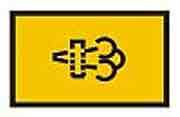What is a Diesal Particulate Filter (DPF)?
A Diesel Particulate Filter, often referred to as the DPF is a filter designed and integrated into the exhaust system to trap & remove Diesel Particulate Matter or Soot from the exhaust gasses of the diesel engine. Much like the Catalytic Converter of conventional petrol engines, the Diesel Particulate Filter works to remove harmful toxins and lower the emissions of your diesel engine making it more environmentally friendly.
The aim is to remove on average 80% of diesel particulate (soot) emissions and although a great concept, it brings about a whole new line of problems. We’re taking calls all day from anxious customers and garages across the country when their DPF (diesel particulate filter) light is illuminated on the dash, indicating that there is at least a partial blockage in the DPF system.
The Problem With Diesel Particulate Filter (DPF) Systems
The DPF works to trap & remove diesel particulate (soot) from the exhaust gasses of the diesel engine before it exits the exhaust into the atmosphere. Imagine a DPF is like a honeycomb on the inside, similar to the Catalytic Converter (CAT) of a petrol engine. As the gasses flow through it, the DPF will trap the harmful diesel particulate (soot) and with it’s advanced technology break it down to remove as much of it as possible (between 80%-100%). The soot is burnt off at very high temperatures in the DPF and left behind is a very fine ash residue. The problem is this ash, it has no where to go and so will begin causing blockage in the DPF system and this is how common DPF Problems occur.
The ash & soot will partially block your DPF causing the DPF light to illuminate on the dash (normally when 45% blockage is reached) at which point regeneration is required to get the DPF back in to it’s safety zone. Regeneration is the method used to clear the DPF blockage through continuously burning it at higher temperatures and allowing the now harmless produce to escape through the exhaust system. There are two types of Regeneration processes which will be explained at the end of the article.

“Limp Mode”. This is the automatic reaction of the Engine Management ECU and if you’re at this stage then unfortunately it will be a costly repair. You could be looking at having to replace the DPF unit and having your Engine Management ECU reprogrammed.
If you do decide to replace the DPF, always use a genuine DPF filter. Copy / pattern DPF filters cause more harm then good. If you want a more affordable and permanent solution to your DPF Problems, then consider our Blocked DPF Removal (DPF-Delete) service.
A DPF replacement will cost you between £800 – £2500 new (+Labour) from main dealers, depending on the Make & Model of your vehicle and the corresponding part numbers of the unit. Resetting the ECU light will cost you a further £45 – 150 and then you will have to be on the lookout for the next time the DPF light comes on to take the appropriate action to ensure the damage is not done all over again.
Common Vehicles Affected By The On-Going DPF Problems
The DPF system is fitted to a wide range of cars and in fact is being installed on almost all new Diesel engines so the problem will in future become more and more common, however, at this moment in time we’ve put together a small list of the most common cars which we’re having to deal with on a weekly basis suffering from the DPF problems.
- Alfa Romeo Diesel Particulate Filter (DPF) problems – Sinspeed DPF Removal Solution
- Audi Diesel Particulate Filter (DPF) problems – Sinspeed DPF Removal Solution
- BMW & Mini Diesel Particulate Filter (DPF) problems – Sinspeed DPF Removal Solution
- Citroen Diesel Particulate Filter (DPF) problems – Sinspeed DPF Removal Solution
- Chevrolet Diesel Particulate Filter (DPF) problems – Sinspeed DPF Removal Solution
- Fiat Diesel Particulate Filter (DPF) problems – Sinspeed DPF Removal Solution
- Ford Diesel Particulate Filter (DPF) problems – Sinspeed DPF Removal Solution
- Honda Diesel Particulate Filter (DPF) problems – Sinspeed DPF Removal Solution
- Hyundai Diesel Particulate Filter (DPF) problems – Sinspeed DPF Removal Solution
- Jaguar Diesel Particulate Filter (DPF) problems – Sinspeed DPF Removal Solution
- Kia Diesel Particulate Filter (DPF) problems – Sinspeed DPF Removal Solution
- Lancia Diesel Particulate Filter (DPF) problems – Sinspeed DPF Removal Solution
- Mazda Diesel Particulate Filter (DPF) problems – Sinspeed DPF Removal Solution
- Mercedes Diesel Particulate Filter (DPF) problems – Sinspeed DPF Removal Solution
- Nissan Diesel Particulate Filter (DPF) problems – Sinspeed DPF Removal Solution
- Opel Diesel Particulate Filter (DPF) problems – Sinspeed DPF Removal Solution
- Peugeot Diesel Particulate Filter (DPF) problems – Sinspeed DPF Removal Solution
- Renault Diesel Particulate Filter (DPF) problems – Sinspeed DPF Removal Solution
- Saab Diesel Particulate Filter (DPF) problems – Sinspeed DPF Removal Solution
- Seat Diesel Particulate Filter (DPF) problems – Sinspeed DPF Removal Solution
- Skoda Diesel Particulate Filter (DPF) problems – Sinspeed DPF Removal Solution
- Toyota Diesel Particulate Filter (DPF) problems – Sinspeed DPF Removal Solution
- Vauxhall Diesel Particulate Filter (DPF) problems – Sinspeed DPF Removal Solution
- Volkswagen Diesel Particulate Filter (DPF) problems – Sinspeed DPF Removal Solution
- Volvo Diesel Particulate Filter (DPF) problems – Sinspeed DPF Removal Solution
What is Passive Regeneration?
Passive regeneration is an automated regeneration which often occurs on drives where there is prolonged high exhaust temperatures like for example on motorway-type runs, but not everyone does long motorway journeys and so manufacturers have had to adapt the technology and design an “active” regeneration process controlled by the Engine Control Unit (ECU).
What is Active Regeneration?
When soot levels in the DPF Filter reach a pre-set limit (normally around 45%), the ECU will make adjustments to the fuel injection timing system to increase the exhaust temperatures and help initiate the DPF regeneration process. This is a smart way of getting temperatures to build up quicker inside the DPF system and begin a full regeneration to bring the unit back to good health, however, if the journey is a bit stop/start where you’re in a built up city with traffic then the chances are the regeneration will not complete and eventually the DPF light will illuminate on the dash to tell you that the DPF system is partially blocked.
At this point it is recommended that you try to find time to complete a full regeneration and this can be done on a simple 10 minutes or so drive of speeds above 40mph.
If you choose to ignore the light and continue in a relatively slow, stop/start pattern of driving. The soot loading will continue to build up and clog up the DPF filter until it reaches closer to 75% blocked at which point you can expect other more serious warning lights to appear on the dashboard. By now, driving at speed alone will no longer be sufficient and the car will need to go to a specialised garage such as Sinspeed or a dealership for regeneration. The other lights may be the engine management light constantly on & possibly even the glow plug light blinking constantly. It would not be advised to continue driving like this to avoid further costly damages to the DPF filter system and other mechanical components.
DPF Additives & How they Work
The most common type of Diesel Particulate Filter (DPF) systems feature an in-built oxidising catalytic converter, which is located close to the engine where you’ll find the exhaust gases will still be relatively hot so that passive regeneration is possible. In some vehicles there’s not always space nearer the engine in which case some manufacturers use a different type of Diesel Particulate Filter (DPF) system, one which relies on a fuel additive to lower the ignition temperatures of the diesel particulate soot particles so that the DPF can be located further away from the engine.
The DPF additive is usually stored in a separate tank and is automatically mixed in with the fuel when you go to fill up. Only very small amounts of the DPF additive are required for regeneration for example on average 1 litre of DPF additive would cover around 2800 litres of fuel, enough to cover 25,000 miles at 40mpg. With this type of DPF, regeneration would be initiated by the ECU roughly every 300 or so miles depending on the vehicle and will normally take 5-10 minutes to complete. Normally you won’t even notice this process taking place and if anything, once regeneration is completed you might see a glimpse of white smoke exit the exhaust and that’s it.
MOT Visual Inspection
From February 2014 the inspection of the exhaust system carried out during the MoT test will include a visual check for the presence of a DPF.
A missing DPF, where one was fitted when the vehicle was built, will result in an MoT failure. A vehicle might still pass the MoT visible smoke emissions test, which is primarily intended to identify vehicles that are in a very poor state of repair, whilst emitting illegal and harmful levels of fine exhaust particulate. It is an offence under the Road vehicles (Construction and Use) Regulations (Regulation 61a(3))1 to use a vehicle which has been modified in such a way that it no longer complies with the air pollutant emissions standards it was designed to meet.
Often companies will cut out a DPF pipe from the exhaust and replace it with a straight-pipe which will instantly fail any MOT visual inspection and although we only remove the internals of the filter, making it visually intact.. our DPF Removal services are intended for off-road use only. The potential penalties for failing to comply are fines of up to £1,000 for a car or £2,500 for a light goods vehicle.
Vehicle Handbook Advice
If you’re buying a new or fairly new diesel car with the DPF system fitted then it’s crucial that you read the relevant sections of the vehicles information handbook so that you understand exactly what actions are advised to take by your manufacturer as advice may vary depending on the vehicle.

Ajaz is a seasoned automotive electronics engineer with deep expertise in remanufacturing vehicle electronics. He has developed skills in all areas of the automotive field, from rebuilding hydraulic steering components, and mechanical gearboxes and reworking intricate vehicle electronics. Ajaz also acquired Bodyteq, a London-based vehicle bodyshop where he has developed extensive knowledge in automotive refinishing.
Alongside his automotive career, Ajaz has built a career in the IT industry, gaining accredited certification as an AWS Certified Cloud Practitioner, Cloud Architect, and Search Engine Optimisation (SEO) specialist.
hi
Please can you confirm to me that my car is still booked in for its dPF removal & Regen work on the 16th march job ref:J****** as I could not access this on the tracking page. Also I am traveling 100 miles to yourselves and am writing to confirm your opening times. As explained previously I intend to arrive early for it to cool down enough to be worked on and return the same day due to my work commitments.
ps: My email contact is all lower case
Regards
mark h*****..07949******
My vehicle is a Mitsubishi Shogun 3.2D brought from UK and has DPF problem. Iam in Lusaka Zambia. How can you assist?
Hi Team,
I have a mercedes e350 brought from UK and has DPF problem, I am in Algeria.
how can you assist?
thanks.